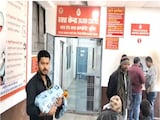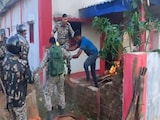Shimla, the queen of hills, was once the summer capital of the British. It was originally planned for a population of 25,000. The British planned Shimla strictly in consonance with its contours and levels of topography. Cut to the present - unplanned and indiscriminate development in the core, non-core, green and rural areas within the Shimla planning area has given rise to serious environmental and ecological concerns.
The population of Shimla is around 2.41 lakh, as of Census 2011, besides a floating population of some 70,000 tourists per day during peak season. The hill station lacks a public transport system, parking space and pedestrian infrastructure.
The new draft Shimla Development Plan (SDP) was commissioned to ensure Shimla's sustainable growth and expansion, keeping in mind its ecological and topographical challenges. The SDP will supersede the Interim 1979 plan, which guided development work in the Shimla Municipal area. The new plan includes areas around Shimla such as Kufri, Shoghi and Ghanahatti special areas and additional villages.
The Himachal Pradesh government issued the draft SDP in June, aiming to regulate construction activities in the city. The plan was approved by the previous government in February 2022, but it did not materialise as the National Green Tribunal (NGT) held it, terming it illegal and in conflict with orders in 2017 to regulate haphazard construction in Shimla.
The draft SDP was approved again after a Supreme Court order on May 3. The top court had asked the state government to decide on the 97 objections received on the draft development plan.
Recently, the Supreme Court stressed that it would examine the plan with a focus on balancing development and environment. The case will come up this week.
The SDP, named Vision 2041, once implemented, will permit construction in 17 green belts with certain restrictions, and also in the core area where construction activity was banned by the National Green Tribunal.
The tribunal had appointed an expert committee to study the impact of existing structures on the environment and ecology, sewage system and water supply of Shimla in 2015. The draft plan ignores the committee's report of 2017, which pointed out that Shimla had far exceeded its carrying capacity from a disaster risk management viewpoint. Unbridled and unsafe constructions on slopes exceeding 70 degrees has made the hill city susceptible to landslides during rain and cloudbursts. In the event of earthquakes, there will be huge loss of lives and property, the report warned. The committee recommended urgent decongestion of Shimla.
In fact, a hazard, vulnerability and risk assessment carried out by the Shimla Municipal Corporation, funded by United Nation Development Programme in 2016, mentioned that 65% of some 2,795 buildings it surveyed were in the criteria of 'high vulnerability'. Similarly, 28% of the houses have had some form of fire accident.
If the draft plan is approved, people can use their attic as a habitable area and increase its height to 3.5 metres. The construction of a one-storey structure with a habitable attic will be permissible in 17 green belts. Two storeys with a habitable attic and parking in core areas, and three storeys with parking and a habitable attic in non-core areas, will also be allowed.
The SDP is completely silent on whether the core infrastructure will be able to support these additions.
Tikender Singh Panwar, former deputy mayor of Shimla, says, "The SDP is inherently flawed. The basic flaw is that unlike the plains, Shimla is a cone-shaped topography and the single land use plan applied in plains can't be applied to the state's terrain to decide on basic infrastructure. In the southeast part of the mountain, the rocks generally tend to be stronger than in the northwestern part and therefore, you see most British bungalows were constructed in the area where there was a slightly stronger strata, and they did not go beyond a certain height."
In the core area, he explains, there are places where the rock is strong but as one goes vertical in the same zone (high traumatized zone) the rock is extremely vulnerable. "Shimla requires zonal planning, based on solid scientific, geological findings. Unfortunately, the mapping hasn't been done on zone or sub zone basis," Mr Panwar says.
According to the Himachal Pradesh government's official data, 91 people lost their lives from June 24 to July 13. Thirty-four deaths were due to landslides, cloudbursts and flash floods. Apart from fatalities and property damage, the rain fury brought lives to a standstill with more than 1,000 roads, damaged bridges, power and water supply lines shutting down.
Experts have repeatedly warned about increasing incidents of cloudbursts due to climate change in Himachal Pradesh and other Himalayan states like Jammu and Kashmir and Uttarakhand. Shimla falls in the seismic zone IV (high damage risk zone) according to the report, and as far as landslide hazard is concerned, 51% of the area is in moderate and 33% cent in the "high hazard" zone. Given the risk, the report said, 5,000 to over 20,000 people might die in the city in the event of a significant earthquake.
Unplanned and haphazard development increases people's susceptibility to natural disasters by increasing their physical exposure. The green tribunal had barred any construction activity in the core and green areas but the new draft SDP permits construction in these areas.
Another obvious flaw is in the projected total population of 6.25 lakh - both resident and floating - for the year 2041.
"The kind of population projection is absurd. The growth rate of town in SDP has been calculated as 400%. That's ridiculous. No town grows 400% anywhere in India or world. Shimla is 55% forest. So where would people construct houses? The SDP doesn't talk of decongestion. The green zones that the SDP will allow construction in will only help powerful people, who have bought land in the green area. There is no talk of mobility in the SDP. We require suturing and acupuncture in the development plan in the form of redevelopment, retrofitting," says Mr Panwar.
The Shimla Development Plan must not be implemented in haste. Scientific and geological inputs should be given priority in the plan to ensure sustainable development of the city and the safety of its citizens.
(Bharti Mishra Nath is a senior journalist)
Disclaimer: These are the personal opinions of the author.















